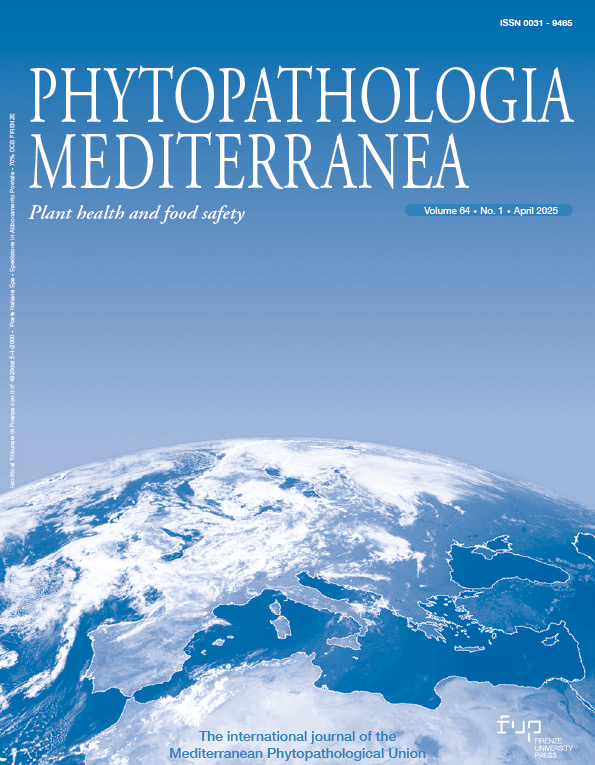Published 2025-05-14
Keywords
- Nerium oleander,
- Xanthomonas,
- bacterial disease,
- Hungary
How to Cite
Copyright (c) 2025 Attila FODOR, László PALKOVICS, Anita VÉGH

This work is licensed under a Creative Commons Attribution 4.0 International License.
Abstract
Nerium oleander L is a long-lasting flowering vegetatively propagated ornamental plant of the Mediterranean region, where it is a major imported flowering pot plant. Only a few bacteria can infect it such as Pseudomonas savastanoi pv. nerii, Agrobacterium tumefaciens and Xylella fastidiosa. Between 2018 and 2022 we collected several infected plant parts in our country. In 2020 we observed atypical symptoms on the leaves and stems, which were not clearly similar to the known bacterial infection of oleander. In our work, we aimed to identify the pathogen. The isolates formed yellow-coloured bacterial colonies on King-B and on YDC agar, were Gram-negative, oxidase negative and induced hypersensitive reaction on tobacco leaves. The biochemical properties were determined by API 20E and API 50CH tests. Brown necrosis was observed on oleander leaves in a pathogenicity test. Multilocus sequence analysis was used for molecular identification of the pathogen. Three housekeeping genes (gyrB, fyuA and rpoD) were amplified. According to symptoms, colony morphology, biochemical features, pathogenicity and molecular methods, the pathogen was identified as Xanthomonas arboricola. This is the first report of the plant pathogenic Xanthomonas spp. on oleander.
Downloads
References
- Backer A., Katzen F., Puhler L., Ielpi L., 1998. Xanthan gum biosynthesis and application: a biochemical/genetic perspective. Applied Microbiology and Biotechnology 50: 145–152. https://doi.org/10.1007/s002530051269 DOI: https://doi.org/10.1007/s002530051269
- Bradbury J.F., 1984. Genus II Xanthomonas (Dowson 1939). In: Bergey’s Manual of Systematic Bacteriology (Krieg, N.R., Holt, J.G. ed) vol. 1. The Williams & Wilkins Co., Baltimore, 199-210.
- Bull C.T., Koike S.T., 2015. Practical benefits of knowing the enemy: modern molecular tools for diagnosing the etiology of bacterial diseases and understanding the taxonomy and diversity of plant-pathogenic bacteria. Annual Review of Phytopathology 53: 157–180. https://doi.org/10.1146/annurev-phyto-080614-120122 DOI: https://doi.org/10.1146/annurev-phyto-080614-120122
- De Kam M., 1984. Xanthomonas campestris pv. populi, the causal agent of bark necrosis in poplar. Netherlands Journal of Plant Pathology 90: 13–22. https://doi.org/10.1007/BF02014178 DOI: https://doi.org/10.1007/BF02014178
- Fodor A., Palkovics L., Végh A., 2022. First report of Serratia marcescens from oleander in Hungary. Phytopathologia Mediterranea 61: 311–317. https://doi.org/10.36253/phyto-13354 DOI: https://doi.org/10.36253/phyto-13354
- Kennedy J.F., Bradshaw I.J. 1984. Production, properties and applications of xanthan. Progress in Industrial Microbiology 19, 319–371.
- King E.O., Ward M.K., Raney D.E., 1954. Two simple media for the demonstration of pyocyanin and fluorescin. Journal of Laboratory and Clinical Medicine 44: 301–307.
- López M.M., Lopez-Soriano P., Garita-Cambronero J., Beltrán C., Taghouti G., … Marco-Noales E., 2018. Xanthomonas prunicola sp. nov., a novel pathogen that affects nectarine (Prunus persica var. nectarina) trees. International Journal of Systematic and Evolutionary Microbiology 68(6): 1857–1866. https://doi.org/10.1099/ijsem.0.002743 DOI: https://doi.org/10.1099/ijsem.0.002743
- Osborn A.M., Moore E.R., Timmis K.N., 2000. An evaluation of terminal-restriction fragment length polymorphism (T-RFLP) analysis for the study of microbial community structure and dynamics. Environmental Microbiology 2: 39–50. https://doi.org/10.1046/j.14622920.2000.00081.x DOI: https://doi.org/10.1046/j.1462-2920.2000.00081.x
- Parkinson N., Aritua V., Heeney J., Cowie C., Bew J., Stead D., 2007. Phylogenetic analysis of Xanthomonas species by comparison of partial gyrase B gene sequences. International Journal of Systematic and Evolutionary Microbiology 57(12): 2881–2887. https://doi.org/10.1099/ijs.0.65220-0 DOI: https://doi.org/10.1099/ijs.0.65220-0
- Parte A.C., Carbasse S.J., Meier-Kolthoff J.P., Reimer L.C., Göker M., 2020. List of Prokaryotic names with Standing in Nomenclature (LPSN) moves to the DSMZ. International Journal of Systematic and Evolutionary Microbiology 70(11): 5607–5612. https://doi.org/10.1099/ijsem.0.004332 DOI: https://doi.org/10.1099/ijsem.0.004332
- Powers E.M., 1995. Efficacy of the Ryu nonstaining KOH technique for rapidly determining gram reactions of food-borne and waterborne bacteria and yeasts. Applied and Environmental Microbiology 61: 3756–3758. https://doi.org/10.1128/aem.61.10.3756-3758.1995 DOI: https://doi.org/10.1128/aem.61.10.3756-3758.1995
- Rudolph K., 1993. Infection of the plant by Xanthomonas. In: Xanthomonas (Swings J. G., Civerolo E. L. ed) Chapman and Hall, London. 193–264. DOI: https://doi.org/10.1007/978-94-011-1526-1_4
- Ryan R.P., Vorhölter F.J., Potnis N., Jones J.B., Van Sluys M.A., … Dow, J.M. 2011. Pathogenomics of Xanthomonas: understanding bacterium-plant interactions. Nature Reviews Microbiology 9(5): 344–355. https://doi.org/10.1038/nrmicro2558 DOI: https://doi.org/10.1038/nrmicro2558
- Smith C.O. ,1906. A Bacterial disease of oleander. Bacillus oleae (Arcang.) Trev. Botanical Gazette, 42(4): 301–310. DOI: https://doi.org/10.1086/329014
- Tamura K., Nei M., 1993. Estimation of the number of nucleotide substitutions in the control region of mitochondrial DNA in humans and chimpanzees. Molecular Biology and Evolution 10(3): 512–526. https://doi.org/10.1093/oxfordjournals.molbev.a040023 DOI: https://doi.org/10.1093/oxfordjournals.molbev.a040023
- Tamura K., Stecher G., Kumar S., 2021. MEGA 11: Molecular Evolutionary Genetics Analysis Version 11. Molecular Biology and Evolution. 38(7): 3022–3027. https://doi.org/10.1093/molbev/msab120 DOI: https://doi.org/10.1093/molbev/msab120
- Taylor R.K., Hale C.N., Hartill, W.F.T., 2001. A stem canker disease of olive (Olea europaea) in New Zealand. New Zealand Journal of Crop and Horticultural Science 29(3): 219–228. https://doi.org/10.1080/01140671.2001.9514181 DOI: https://doi.org/10.1080/01140671.2001.9514181
- Temsah M., Hanna L., Saad A.T., 2010. Histological pathogenesis of Pseudomonas savastanoi on Nerium oleander. Journal of Plant Pathology 92(2): 407–413.
- Trébaol G., Gardan L., Manceau C., Tanguy J. L., Tirilly Y., Boury S., 2000. Genomic and phenotypic characterization of Xanthomonas cynarae sp. nov., a new species that causes bacterial bract spot of artichoke (Cynara scolymus L.). International Journal of Systematic and Evolutionary Microbiology 50(4): 1471–1478. DOI: https://doi.org/10.1099/00207713-50-4-1471
- Vauterin L., Hoste B., Kersters K., Swings J., 1995. Reclassification of Xanthomonas. International Journal of Systematic and Evolutionary Microbiology 45(3): 472–489. https://doi.org/10.1099/00207713-45-3-472 DOI: https://doi.org/10.1099/00207713-45-3-472
- Vicente J.G., Holub E.B., 2013. Xanthomonas campestris pv. campestris (cause of black rot of crucifers) in the genomic era is still a worldwide threat to brassica crops. Molecular Plant Pathology 14(1): 2–18. https://doi.org/10.1111/j.1364-3703.2012.00833.x DOI: https://doi.org/10.1111/j.1364-3703.2012.00833.x
- Young J.M., Park, D.C., Shearman H.M., Fargier E., 2008. A multilocus sequence analysis of the genus Xanthomonas. Systematic and Applied Microbiology 31(5): 366–377. https://doi.org/10.1016/j.syapm.2008.06.004 DOI: https://doi.org/10.1016/j.syapm.2008.06.004
- Young J.M., Wilkie J.P., Park D.C., Watson D.R.W., 2010. New Zealand strains of plant pathogenic bacteria classified by multi‐locus sequence analysis; proposal of Xanthomonas dyei sp. nov. Plant Pathology 59(2): 270–281. https://doi.org/10.1111/j.1365-3059.2009.02210.x DOI: https://doi.org/10.1111/j.1365-3059.2009.02210.x






